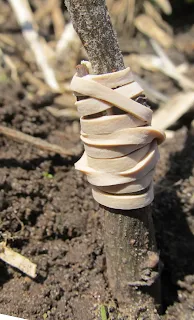 |
| A sucker from a quince bush that was moved into the orchard to serve as a rootstock. It was moved a couple of months ago during a thaw and its roots have been settling in. It is about four feet tall and is in a basin about two inches deep where the fill subsided. |
 |
| Cut back to three inches of height. I find that I can work with a three inch stub without plunging the knife into my thumb. I have scars... |
 |
| Rubber bands are awesome. Stretch them as you wind them on and they will suck gaps closed. I use common #32 or #33 that I buy by the pound bag. |
 |
| Then I wrap the rest of the scion with a product called Parafilm-M. It is stretchy and adheres to itself and the buds can grow right through it. I suspect it is also permeable to oxygen. |
 |
| Then I make a personal greenhouse from my collection of used milk jugs. |
 |
| I cut a 6" diameter hole in the bottom. I cut off the top. I sever the handle as shown. |
 |
| Then I jam a piece of rebar through the hole to stake it in place. I run the stake on the windward side of the grafted plant so the wind is less likely to bat the jug against the young plant. |
Notes for my records:
South row starting from the east end:
- One tree of Rombough from the collection curated by L. Pittman
- One tree of Claribel
- Two trees of Skorospelka
- Four trees of Tashkent
- One rootstock too short to graft
- Two trees of Claribel
- One dead rootstock
- One rootstock too short to graft
 |
| Gnarly looking. |
- One tree from scion collected in the alleyway between Clemens and Fairview near Kalamazoo Avenue
- Two Pigwa S-1





No comments:
Post a Comment
Readers who are willing to comment make this a better blog. Civil dialog is a valuable thing.